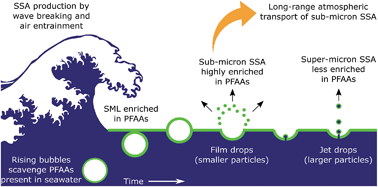Global transport of perfluoroalkyl acids via sea spray aerosol†
Abstract
Perfluoroalkyl acids (PFAAs) are persistent organic pollutants found throughout the world's oceans. Previous research suggests that long-range atmospheric transport of these substances may be substantial. However, it remains unclear what the main sources of PFAAs to the atmosphere are. We have used a laboratory sea spray chamber to study water-to-air transfer of 11 PFAAs via sea spray aerosol (SSA). We observed significant enrichment of all PFAAs relative to sodium in the SSA generated. The highest enrichment was observed in aerosols with aerodynamic diameter < 1.6 μm, which had aerosol PFAA concentrations up to ∼62 000 times higher than the PFAA water concentrations in the chamber. In surface microlayer samples collected from the sea spray chamber, the enrichment of the substances investigated was orders of magnitude smaller than the enrichment observed in the aerosols. In experiments with mixtures of structural isomers, a lower contribution of branched PFAA isomers was observed in the surface microlayer compared to the bulk water. However, no clear trend was observed in the comparison of structural isomers in SSA and bulk water. Using the measured enrichment factors of perfluorooctanoic acid and perfluorooctane sulfonic acid versus sodium we have estimated global annual emissions of these substances to the atmosphere via SSA as well as their global annual deposition to land areas. Our experiments suggest that SSA may currently be an important source of these substances to the atmosphere and, over certain areas, to terrestrial environments.

- This article is part of the themed collections: Best Papers of 2019 from RSC’s Environmental Science family journals, Best Papers 2019 – Environmental Science: Processes & Impacts and ESPI Cover Art 2019


 Please wait while we load your content...
Please wait while we load your content...